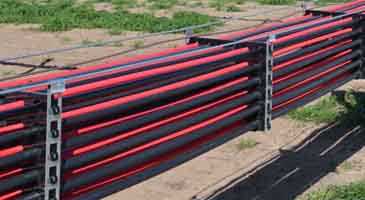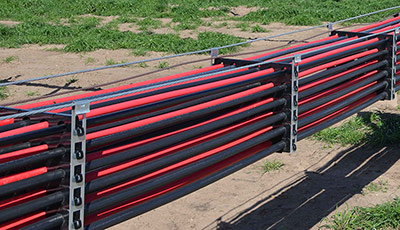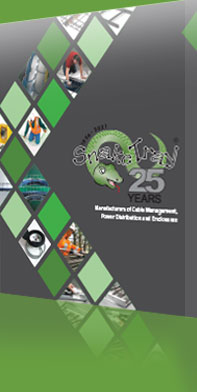Maximize R.O.I, Reduce Costs and Harvest More Energy with Snake Tray Solar Snake Max™
The ultimate goal of every solar plant is to generate clean energy and harvest as much power as possible while consuming the fewest resources as possible to maximize ROI. Advances in photovoltaic cell technology combined with falling costs and a push by the federal government for renewable energy has made solar power more popular than ever.
This article explains how the free-air solar cable conveyance system by Snake Tray, the Solar Snake Max™, helps utility-grade solar plants squeeze the most wattage out of every dollar spent on labor and materials to improve profitability. It will also touch on several Snake Tray products designed to optimize cable organization and protection from the solar panel arrays all the way to termination points, like the 407 Series Solar Snake Tray, the Solar Ice Guard, and Solar Click-n-Go Hanger. For more information on any of the topics covered here, simply click on the links provided to read the full article.
Solar Plant Cable Management Options
Large-scale engineering marvels, utility-grade solar plants occupy hundreds of acres with rows upon rows of solar panels tightly packed into avenues for maximum energy capture. Beneath these arrays are equally intricate pathways of high ampacity DC power cables transporting direct current to inverters at the end of each row. Also along these routes are low voltage lines for sensors that monitor weather conditions and panel performance, as well as the motors that enable the panels to track the path of the sun. Solar plant developers have several options when cabling the arrays:
- Buried cable. Laying cable directly in the ground involves trenching and overcoming issues and delays caused by weather and hidden geological obstacles. Labor intensive and expensive, cable repairs are also costly and hindered by lack of visibility to an exact failure point. Further, engineers must compensate for the effects of derate, the percentage reduction in cable wattage capacity required to offset heat buildup, as earth traps heat.
- Running cables inside pipes. The cables are still trenched and buried, but are protected from moisture and the crushing weight of earth. Derate factors actually can be higher due to heat entrapment by the pipes, but repairs are easier as cables can be pulled and replaced without digging.
- Bundling cables above ground. Running cables above ground is faster, less expensive to install, avoids trenching issues and provides a high level of accessibility for repairs. Above ground cabling will experience some derate due to the cables touching, but less than when inside a pipe.
- Free air installation. Cables run above ground using separators to allow heat to dissipate into the surrounding air. As a result, free air installation greatly lowers or completely eliminates derate, which can reduce cable impedance by 25% to 40% over an entire project. Plus, its relatively low material costs and minimal labor requirements compared to trenching make it a very economical solution.
Related Article:
Solar Cable Management: The Cost Savings of Free Air Solar Cable Installation
Solar Plant Location Options: Dwindling Choices
Ever-increasing demand for electricity is forcing utilities and energy providers to build new sources of power. Unfortunately, many of the prime locations for hyperscale solar farms are either gone, too expensive, or not in proximity to growing population centers.
As a result, utility-grade solar arrays are being constructed on less desirable lands, repurposing agricultural farmlands, defunct shopping malls, even Superfund sites, decommissioned power plants, and capped landfills.
The problem with these sites is that trenching is not always the best option or even possible in some cases. Besides the costly and messy process of burying cables, soil conditions can change from one end of the property to the other. There may be unmarked water, waste, communication, and power lines underground on lands previously zoned for commercial use.
Erecting solar arrays on repurposed grazing or farmland presents its own unique challenges. While the land may be tilled and flat, trenching potentially exposes workers to high concentrations of fertilizers, pesticides, and other chemicals accumulated in the soil from decades of growing crops or feeding livestock. There are environmental concerns of topsoil erosion and worries of dangerous organic compounds contaminating water supplies.
This was exactly the case at a 4,200-acre solar plant outside El Campo, Texas. Constructed on what was once agricultural farmland, the developers were concerned that rain-induced runoff containing hazardous chemicals brought to the surface by trenching could enter the local water supply. By implementing Snake Tray’s free air cable conveyance system, the project not only eased neighbors’ environmental concerns, but it also saved thousands of labor hours by not digging trenches, and reduced material costs by using lower ampacity cables.
In spite of or even due to the increased use of sub-par locations or repurposed land, free air cable installation offers the path of least resistance. This method speeds cable installation, reduces labor costs, minimizes digging and environmental issues, and is easily serviceable post-construction. Most importantly, free air installation allows solar plants to utilize smaller cables to their maximum capacity for a better ROI.
Related Article:
Hot Trend: Building Solar Arrays Over Open Air Parking Lots – Doing it Right
The Snake Tray Solar Snake Max™ Defined
We have established that free air installation is superior to other methods of cable conveyance used at utility-grade solar plants for a number of reasons. But what exactly is the Snake Tray Solar Snake Max? What makes it better than alternative free air cable conveyance systems?
Unlike other above ground cable management systems that bundle cables together, Snake Tray’s patented Solar Snake Max system is an above ground (aka “free air”) cable management apparatus that uses messenger wire and brackets mounted to the same vertical pilings that support the solar panels.
Cable spacing trays are seated at measured intervals to meet NEC requirements for individual cable spacing over the entire length of a run – without sagging, trenching, or the need to step up in cable ampacity to compensate for derate.
The Solar Snake Max system safely holds cables in place with the proper amount of support and elasticity so that cables are never overstressed, yet cannot touch the ground.
Solar Snake Max is the only system designed to comply with the Free Air Table for electrical current transference as per Article 301 of the National Electrical Code. Its simple snap-together, multi-level bracket design supports up to 36 properly spaced cables from 350 Kcmil to 750 Kcmil in any mixed combination, making it easy for installers to lay cables quickly.
It allows the heat of electrical friction to naturally dissipate into the surrounding air, maintaining the highest possible energy throughput for maximum energy harvest.
Beyond cabling solar arrays on pilings driven into the earth, Solar Snake Max is also an excellent tool to transform large rooftops into renewable energy sources. In fact, the Solar Snake Max system has been used to offset the massive electricity bills of hyperscale data centers, leveraging the real estate of their large flat roofs to generate electricity and serve as an emergency power source.
Related Article:
Snake Tray Helps Data Centers Capture Renewable Energy to Reduce Costs
Snake Tray is Leading the Charge Towards EV Charging Infrastructure Standardization
Top 10 Advantages of the Snake Tray Solar Max
The Snake Tray Solar Snake Max trenchless cable management system solves virtually every conceivable problem related to trenching. It allows for solar plant construction just about anywhere, anytime with minimal environmental impact and ground disturbance, transforming unusable properties into renewable energy producing assets. Here are the top 10 advantages of the Solar Snake Max:
- Material cost savings. Use lower ampacity DC cables to their full capacity.
- Faster install with lower labor costs. Installers can run more cable above ground in two days than can be laid in a week when trenching.
- Maximum return on investment. Maintain code compliant cable separation to achieve a better ROI by harvesting 100% of the power generated.
- Total visibility to cable plant. Everything is above ground for easy visual inspection and fast access to failure points.
- Versatile and expandable. Attaches to any type of vertical piling, traverses any type of terrain. Adding more panels to an existing array? Easily add more cables (up to 36) to the run.
- Eases environmental concerns. Leave the ground as undisturbed as possible.
- Simplified installation, operations, and maintenance. Quickly load cables and keep them separated and suspended to NEC code standards. Simplify ground maintenance.
- Expands development opportunities to less-than-optimal sites. Transform unusable properties into clean energy producing assets.
- Built for the elements. Designed to withstand hurricane-force winds and prolonged exposure to sun, rain, ice, and snow.
- Allows for construction 12 months/year. It may be impossible to trench in winter months, but pilings can be hammered into the ground year round.
Related Article:
Solar Cable Management Safety – Go Beyond NEC Code
There’s a lot more to solar cable management than just making the cables look neat and organized.
Besides resolving the issue of derate, large scale solar arrays must also account for the effects of thermocycling; the daily temperature swings that cause panel structures to move. This can result in stress at cable connection points, broken cables from overtightening, damaged cable trays from inflexible bend radii, and/or sagging if the cables are not supported properly. Loose cables are prime targets for damage by rodents or vandalism. Also, consider solar plant ground maintenance. Vegetation beneath the panels must be cut without damaging cables. Further, a broken cable lying on wet grass puts maintenance personnel at risk.
Despite all of these challenges, the National Electric Code (NEC) section 690.110.12 for the mechanical execution of work states only, “Electrical equipment shall be installed in a neat and workmanlike manner.” This gives contractors a lot of flexibility, but not a lot of direction.
Snake Tray solutions for solar cable management not only exceed NEC 690.110.12, they help improve the ROI of every project. Snake Tray Solar Snake Max eliminates derate while holding high amperage DC power cables safely in place with the proper amount of support, separation, and elasticity to account for panel structure movement caused by thermocycling. Cables never touch the ground, improving ground maintenance and worker safety.
Snake Tray also has a solution for organizing the lower ampacity cables connecting each row of panels. The 407 Series Solar Snake Tray is the world’s only weatherproof, hand-bendable cable conveyance that quickly and securely carries DC circuitry from solar panels to their termination points. Change directions and navigate around obstructions easily by bending Solar Snake Tray without the use of tools. Its patented “lobster trap” design with built-in mounting rings ensures effortless outdoor cable installation, while trapping and protecting the cables from hurricane force winds over 120 mph.
Safety applies to people too, and Snake Tray has that covered as well. In colder climates where ice and snow may collect on angled solar arrays, the Snake Tray Ice Guard is specifically designed to help hold back ice up to the top edge of the panel. The Ice Guard easily mounts to the frame of any solar panel and is a great solution to minimize the possibility of injury from ice sheets sliding off arrays installed over areas with pedestrian traffic such as parking lots and train stations.
Often overlooked are the low voltage lines running AC power to the motors, emergency lighting, and sensors, as well as the network cables under every array. Rather than using zip-ties to bundle these cables together, Snake Tray offers the weatherproof Click-n-Go Cable Hanger to easily convey all low voltage cables without bundling. Simply attach the hangar to the messenger wire and slide into position. Easily add or replace cables without the hassles of cutting and redoing dozens of zip-ties or disturbing the existing cable infrastructure.
Related Article:
Meet the Solar Snake-Loc Hanger: The Future of Efficient Solar Cabling
Create Energy. Store Energy. Use Energy. It’s all in the “Click”.
Beyond the Solar Panel: Storing Solar Energy
Traditionally, solar plants sell 100% of the energy they produce to utilities as it is generated. But as battery technology has improved, the ability to safely store excess clean energy produced during the day for use at night is becoming more popular as a means to keep fossil fuel turbines off a little longer after the sun goes down.
But we’re not talking about a few solar panels feeding a residential battery station to power a Tesla in the garage. Adding battery storage to a utility-grade solar plant means running a duplicate set of high ampacity DC cables from inverters to multiple banks of batteries. That can get expensive as there are many turns, transitions, and connections to reach the inverters at the end of every row – and even more cost prohibitive if it involves trenching and derating buried or bundled cables.
Snake Tray solutions make battery storage more efficient and profitable for solar plants. The prefabricated Solar Snake Max system uses less labor and materials to connect inverters to battery storage arrays, reduces cable convergence by 25% to 40% due to free air installation, and supports the use of advanced connectivity technologies such as Big Lead Assembly (BLA) wire harnesses, eliminating expensive combiner boxes and DC feeders to make battery storage of excess energy more affordable.
Related Article:
Snake Tray’s Cable Management Solution for Battery Energy Storage Systems Makes Every Day Brighter
Solar Snake Max Puts Dollars Back in Your Pocket
Some solutions increase ROI through reduced up-front construction costs, others through enhanced performance during operation. The Snake Tray Solar Snake Max™ system does both. Only Solar Snake Max saves money on materials and labor during construction, and once the plant is online, increases daily energy harvest by up to 8% over traditional trenching methods, and we’ll prove it.
Saving money on materials is accomplished by using lower ampacity cables to their full capacity in free air rather than having to purchase thicker cables to compensate for the effects of derate. Solar plants can save up to 30% on cable costs alone!
Labor costs are reduced by eliminating the need for trenching during construction, as well as significantly speeding the physical laying of cables. Solar plants can reduce construction labor expenses by up to 45%!
Once operational, the Solar Snake Max above-ground cable conveyance system has been proven to harvest thousands of watts of clean power every day that are otherwise lost to the effects of derate. The Snake Tray Resistivity and Savings Calculations Spreadsheet uses calculated physics and precise coefficient values for the resistivity of copper at different temperatures to determine the amount of power lost to Ohmic heating. Algorithms easily convert anticipated power loss percentages into a dollars and cents estimate of incremental revenues that could be realized with Solar Snake Max.
The bottom line: Solar Snake Max reduces costs while increasing revenues. How many cabling solutions can do that? Snake Tray can crunch the numbers to maximize your return on investment with quantitative performance savings rooted in the laws of physics.
Related Article:
Snake Tray – Bringing Predictability to Unpredictable Environments.
Snake Tray cable conveyance systems offer the unique combination of cost reduction and simultaneous revenue enhancement.
Totally prefabricated for faster, safer installation, there is no cutting, no grinding of sharp edges, and no special tools required for installation. Use less expensive labor and fewer materials to construct cable pathways in less time.
Solar Snake Max components easily snap together and are weatherproof for years of reliable performance in the harshest conditions. Totally expandable, reusable, and made with reclaimable materials, all Snake Tray products are manufactured in the USA and are inventoried across a network of distribution centers for fast delivery to the job site.
Best of all, above ground, free air cable installation eliminates the issue of derate so that solar plants can harvest the maximum amount of clean energy generated every day for increased revenues.
In addition to meeting the primary challenge of transporting large amounts of DC current on high ampacity cables with Solar Snake Max, Snake Tray offers innovative solutions for every aspect of cabling utility-grade solar plants. From trays carrying low capacity DC cables and low voltage AC lines to cable hangers and ice guards, Snake Tray is your one stop shop for solar cable conveyance solutions.
One way or another, solar plants need reliable cabling solutions to transport photovoltaic energy from every single panel on every single array to inverters, and to connect to the power grid. Might as well use a system that saves money on the front end and harvests more power at the back end. Plus, Snake Tray has an entire team of solar engineers ready to help design your next project and provide a true measure of the incremental revenues that could be realized with Solar Snake Max.
At Snake Tray, everything we do is built on a corporate culture that focuses equally on customer satisfaction and employee self-actualization. We’re a family. That’s how we’ve kept the team together, grown, and consistently brought innovation to the cable management and power distribution market for the past 25 years. We’re Snake Tray, and we bring predictability to unpredictable environments.
Related Article:


